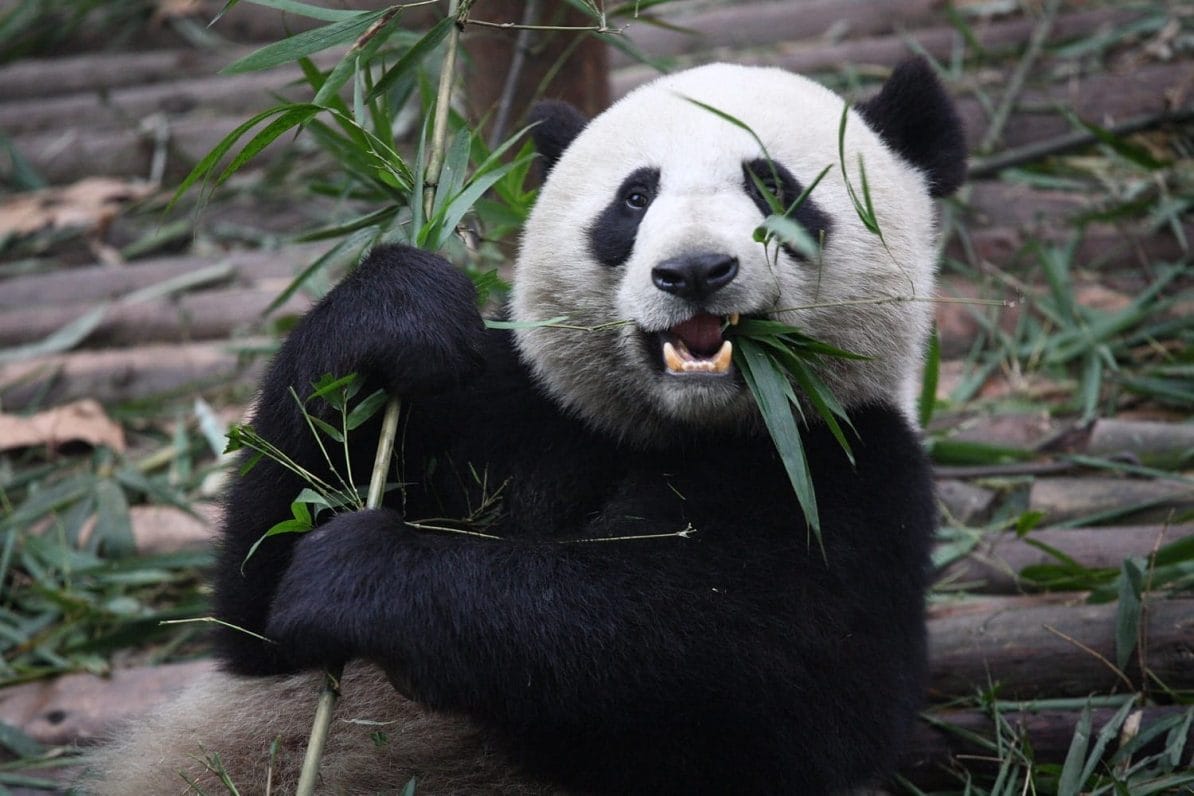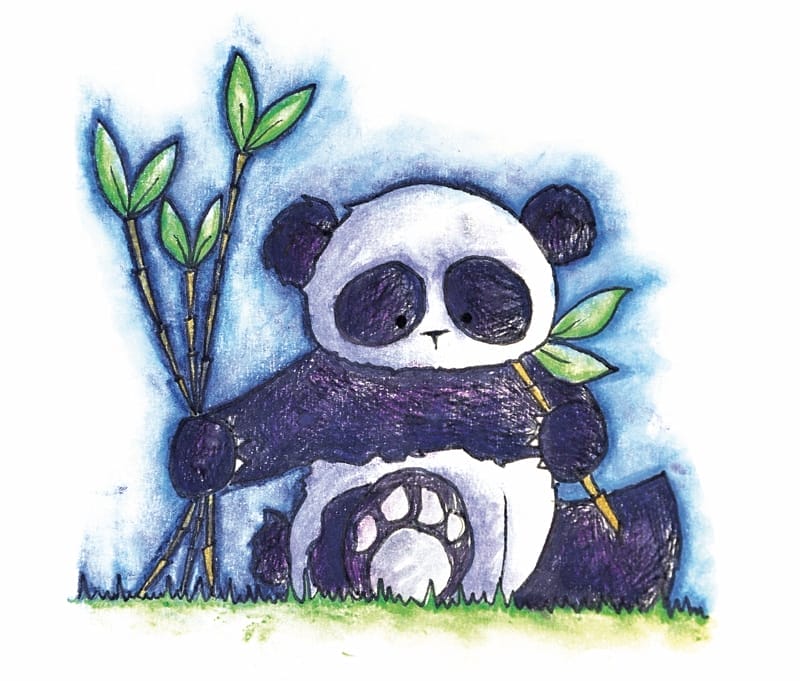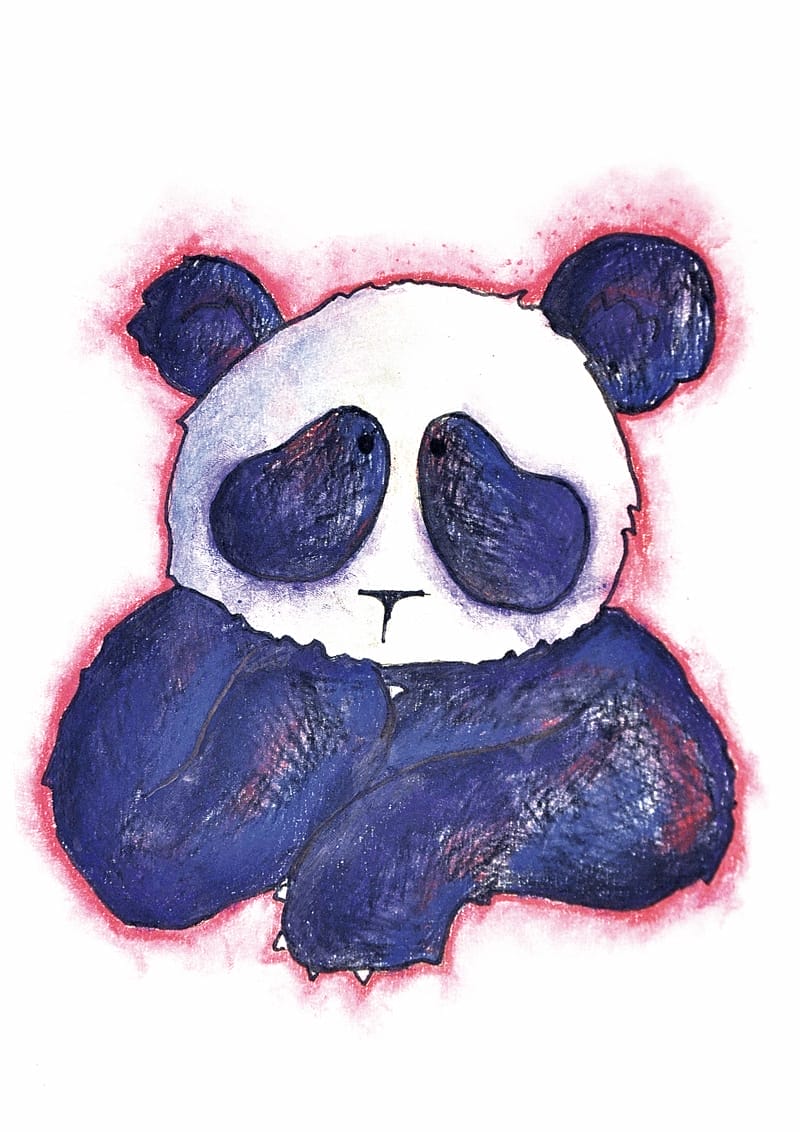Why the giant panda is a giant liability
Two of the star attractions at Edinburgh Zoo – giant pandas Tian Tian and Yang Guang – arrived in December 2011 following a £6 million deal struck with the Chinese government in January of that year. Can we afford to keep these layabout animals, asked Alan Rutter at the time. And how do we justify the cost of propping up a species that doesn’t appear to want to be saved?

Photo: Chen Wu / Wikimedia Commons
Illustrations: Anne Gerrish
10th January 2011 (Taken from: #2)
The Ailuropoda melanoleuca, or giant panda, is a complete design failure. A carnivore by taxonomic designation, it has chosen to exist by eating 99 per cent bamboo – a diet so low in nutrition that it must be consumed almost constantly, with up to 14kg a day shovelled in just to achieve basic sustenance.
The limited energy supplied by this diet requires the panda to avoid exercise of any kind. So, despite the fact that its natural habitat is disappearing fast, it cannot, of its own volition, go off in search of a better environment. Estimates of the wild population of pandas range from 1,500 to 3,000, clustered in the dwindling mountain countryside of a nation (China) with a fairly hefty population (1.3 billion people) that’s becoming increasingly industrialised and urbanised. The panda contents itself with eating a bit more bamboo, and defecating up to 40 times a day.
For the panda, even more than for humans, mating is famously complicated. The oestrous cycle of the female lasts for two to three days, once a year and the male is often unaware that nearby females are on heat. Copulation time ranges from 30 seconds to five minutes, but even this brief encounter is too much work for most male pandas. We – well, I haven’t, but humans – have tried our best to help. Keepers in Sichuan dress up as pandas in order not to distress the animals and put them off. Sperm is frozen in liquid nitrogen to be shipped around the world for artificial insemination. At Chiang Mai Zoo captive pandas were shown videos of other pandas mating. At Wolong Nature Reserve a male panda called Zhuang Zhuang (literally, and inappropriately, ‘strong strong’) was given Viagra in a last-ditch attempt to get him in the mood. All in vain.

As a species the panda has listlessly flopped its way towards the abyss of extinction. But somehow en route it has fallen on to a particularly comfy sofa, and immediately been presented with porn and snacks. The Giant Panda is such a design failure that creationists have pointed to it as proof of the existence of God – because if survival of the fittest worked, what on earth is this freak doing here? And, more importantly, why are we so determined to keep it going?
This isn’t a question only asked by the bemused layperson. In September 2009, established wildlife expert and passionate conservationist Chris Packham (he of UK TV shows The Really Wild Show and Autumnwatch) told the Radio Times magazine: “We pour millions of pounds into panda conservation. I reckon we should pull the plug. Let them go, with a degree of dignity.” It wasn’t the first time he’d made similar comments – the previous year he’d yet to develop the “dignity” theme, and simply said: “I’d eat the last panda if I could have the money we’ve spent on panda conservation back on the table for me to do more sensible things with.”
Other animal-lovers may not take Packham’s extreme stance, but they echo the view that a lot of money is being spent on keeping animals in cages. The People for the Ethical Treatment of Animals Foundation (PETA) has objected to the Edinburgh deal on the grounds that “Pandas are complex, sensitive, intelligent beings who suffer boredom, frustration and loneliness in captivity and deserve to be left in peace”. Which, presumably, includes a peaceful demise.
But putting the morality of keeping pandas in captivity to one side, what about the question of cash: in these lean times, can we justify chucking money at the panda?
I am convinced Scotland does not need pandas any more than pandas need Scotland”
The loan of the giant pandas to Edinburgh Zoo will cost an estimated £6m – and at the time of press the zoo had yet to secure a sponsor to cover this outlay. “I am convinced Scotland does not need pandas any more than pandas need Scotland,” said Will Travers, chief executive officer of the Born Free Foundation. “It appears commercial sponsors, quite rightly, have other priorities and may share our view [that] this whole thing is little more than animal exploitation.”
Iain Valentine is director of animals, conservation and education at the Royal Zoological Society of Scotland (RZSS), and has been involved in the negotiations over the current deal. “They’re not more expensive than other animals,” he insists. “It will probably cost £70,000 a year to feed the pair – they’re obviously quite specific in what they eat. We’ve got a bamboo supplier in Germany currently. But we’re looking to establish our own plantation – we only need ten acres or so – which would bring the cost down. As a comparison, a koala costs £21,000 a year to feed; the eucalyptus comes up from Cornwall.”
People don’t always realise that giant pandas can only be released from China if authorised by the premier”
However, it’s the money that goes to China that accounts for the millions – and on the specifics of this, Valentine is less forthcoming. “We’ll work out a research plan that will be implemented over the next ten years,” he says. “It will either be a financial contribution to help with conservation work, or shared funds to go into research. At the moment we’re working out what they want, and what we can do.”
Whatever form the Edinburgh deal takes, it’s clear that these arrangements inevitably result in a lot of money going to China. Zoo Atlanta in the US pays around $2m (£1.3m) a year to the Chinese government for its own pair of pandas, Lun Lun and Yang Yang. Human rights campaigners, among others, have issues with these payments going to the current Chinese regime – a regime which is well aware of the positive propaganda value of the giant panda. The Edinburgh deal was signed at Lancaster House in a ceremony witnessed by both deputy prime minister Nick Clegg and vice premier of China Li Keqiang.

Valentine admits that the the deal was deeply political. “People don’t always realise that giant pandas can only be released from China if authorised by the state council – basically sanctioned by the premier,” he says. “So these are highly political animals, and they’re lent as a sign of friendship between nations.”
But for Valentine the deal is about the people of China and the UK, rather than their governments. “For me the exciting part of this project is what we as an organisation can do to help the giant pandas by helping the people of the UK to know more about China,” he says. “It’s about citizenship. It won’t be the people of Britain that save pandas – it will be the people of China. Just as in Scotland or the UK, it will be us that protect or save our own native species or ecosystems.”
Assuming that there will be a hefty fee going to China, it’s not as if Edinburgh Zoo (and Scottish tourism) are being entirely profligate – there’s a business plan in the background. The Edinburgh pandas, Tian Tian and Yang Guang, will be the first in the UK for 17 years, and the zoo spent five years negotiating the deal. The zoo can expect to benefit directly from having the animals – visitor numbers jumped 70 per cent at Adelaide Zoo when it took delivery of a couple of pandas. Edinburgh Zoo had around 570,000 visitors in 2010 – this is estimated to rise to over a million with the pandas in place.
What is the priority here for the zoo: to pull in crowds, or a realistic endeavour to save pandas?”
And there are people who believe that panda projects are more about the show than real conservation. “We always have reservations about captive breeding programmes because they don’t have a very high rate of success,” says Libby Anderson, a spokeswoman for Advocates for Animals (now known as OneKind), of the Edinburgh pandas. “If you’re going to carry out breeding programmes, do it in the wild. The pandas were described in the press as a great crowd-puller. You have to ask what is the priority here for the zoo: is it to pull in crowds, to use animals for entertainment or a realistic endeavour to save pandas?”
Here, Valentine is more forthright. “People making these arguments have little understanding of what’s been happening in China for many years,” he says. “Firstly, the captive population of giant pandas is a reserve for the wild population. Secondly, and more importantly, the captive population will be used in next five years to augment the wild population. The wild populations are broken up geographically and genetically, so we need to reintroduce pandas from the breeding centres.
“There are about 1,500 pandas in the wild, we’re not quite sure. There are about 312 pandas in captivity. That’s a really important number to get to. Once you have around 300 individual animals, that should represent 95-98 per cent of the genetic diversity of the species – which means you’re replicating in captivity what exists in nature. That’s what the Chinese are seeking to do. The long-term plan is that at the end of the day there will be a viable wild population.”
The end of the day may be some way off – and this plan, though ambitious, may not work. The brutal truth is that pandas could be snipped out of their ecosystem with little or no effect on the creatures around them. No species is dumb enough to rely on them for survival, and they keep no other species in check – it’s not like bamboo would run amok if the panda stopped casually chewing. So why do we keep these fluffy parasites going?
Firstly, we know deep down that the blame for destroying the panda’s habitat is ours. Having caused the panda’s plight we have a duty of care – like hitting somebody in your SUV and then paying for their life support. It’s species guilt.
But there’s also the simple fact that pandas are cute. Other animals are too – or if not cute, then at least impressive and easy to empathise with. These big beasts – usually near the top of the food chain, large enough to be impressive and much more interesting to look at than any of the 10 million species of insects on the planet – are known as ‘charismatic megafauna’. Bengal tigers, elephants, orangutans, marine turtles, polar bears – these are all mainstays of conservation poster campaigns.
The panda is particularly suited to seducing us Homo sapiens. To create a cuddly toy based on any other animal it’s necessary to anthropomorphise, cartoonify and generally ‘cute up’ the creature as it appears in the wild. Pandas come ready-made: a correctly scaled model of a panda is a cuddly toy.
Valentine concedes that the panda does get more attention for these reasons. “Since the 1960s, when the World Wildlife Fund (WWF) chose the panda as its symbol, the world has recognised that the giant panda represents all of our efforts in conservation,” he says. “There’s a feeling that if we can’t save the panda – this charismatic, cute megafauna – what can we save? It’s hard to get people excited about snails in French Polynesia.”
The giant panda has identified the most terrifying species on the planet, and seduced it”
Charismatic megafauna are the brand ambassadors of the conservation movement – the frontmen of the preservation societies, the swaggering lead singers that bring in the punters and ensure that the less glamorous band members and backstage staff (and bugs) get paid. Organisations such as the WWF carry out plenty of less high-profile work than rescuing pandas – on more abstract projects relating to habitat conservation or environmental issues, or on the preservation of less T-shirt-friendly creatures. But you can guarantee that when it’s time to hit the fundraising trail, pandas bring in the cash better than porcupines or pigeons. In 2010 alone the UK arm of the WWF raised £56,710,000.
And even if we did let the panda die out, there’s nothing to say that the funds directed to them – by governments, charities or zoological institutions – would go to more worthy species. The Chinese have a Great Firewall to maintain and a population to snoop on; charitable donations can go to children in Africa or church roof funds; zoos can invest in chimps and gorillas. The unglamorous, uncharismatic, minor-fauna may well be better off taking what they can get from the cash the panda brings in than trying to go it alone.
In some senses, then, the panda is actually design perfection. Where other species have evolved to survive through their ability to attack, their defensive armour, their speed or intelligence, the panda has taken an entirely different route. It has identified the most terrifying species on the planet, and seduced it. The appearance of the panda provokes instinctive feelings of protectiveness in us humans. We feel we must look after it.
Even its colouring is perfect. When the WWF was developing its logo, it needed something that would work when printed in black and white. The zebra may have put in an application, but this was really a battle only one species of monochromatic charismatic megafauna was going to win.

Slow Journalism in your inbox, plus infographics, offers and more: sign up for the free DG newsletter. Sign me up
Thanks for signing up.








